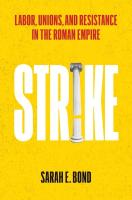
Yale (2025) h/b 254pp £25 (ISBN 978 0300 273 144)
B. begins by pointing out that the good burghers of Sunderland (the Mackems, to some of us), have the credit for inventing the ‘strike’ in 1768 when they struck the topsails in search of better pay and conditions. In fact, the Romans got there much earlier, as this book illustrates in very great detail, though the Egyptian royal tomb-workers seem to have beaten everyone to the post in the 1150s BC because of the late delivery of their grain and beer rations.
Strikes in the Roman world were associated with the collegia (said to have been invented by the early king Numa to heal divisions but that is surely a Roman read-back from the troubles of the 1st C BC). To generalise, these friendly associations of people, usually related by their work, provided (for a fee) the chance to meet socially and dine together and promised them a burial and a memorial urn, with name and job) in the association's columbarium (‘dovecote’) designed for that purpose. But over the years, as B. observes, ‘all manner of private clubs, confraternities, involuntary associations, informal collectives, and formal unions had become commonplace in the ancient Mediterranean in both the West and the East’ and some of them organised themselves to protect their members’ interests especially in the market-place.
B. associates these collegia with the wider story of ‘the Struggle of the Orders’—the plebs’ eventually successful efforts to carve out for themselves a degree of political equality with the ruling classes, mainly by refusing to fight unless they too could share in the decision-making. Her thesis is that ‘using Roman history to examine the ways in which regular Romans banded together in various forms can give us some empathy and insight into the ways that humans cope with marginalised identities, inequality, a lack of public prestige outlets for non-elites, and socio-economic uncertainty’. She also finds parallels between the modern world and the anxieties of the Roman elite about ‘labour collectives, strikes and challenges to state power’, while suppressing the freedom of assembly in Rome, she suggests, is compatible to ‘modern union-busting legislation’.
One does not have to agree with B.’s imposition of modern concepts upon an utterly alien ancient world to find a great deal of interest in her investigations into the growth and development of these collegia. The seven chapters take us in detail through to the 6th century AD, and her concluding chapter hints at their continuation through the Byzantine and Carolingian empires and evolution into the merchant guilds in the Middle Ages and their Christian and Islamic counterparts.
These collegia began to take off as Rome expanded into Greece during the 2nd century BC, and trade began to flourish through the founding of mercantile associations often connected with a god. Delos, for example, became an extremely important centre for slave trading. B. suggests that the slave wars in the second and first centuries BC may have been made possible partly by the existence of such associations.
Increasing numbers of associations of workers—e.g. from cooks and bakers for hire in the marketplaces, to musicians, actors, and athletes wherever there was a demand—sought a range of rights, freedoms and other privileges to enable them to provide their services. The political stances of some of these groups played a part in bringing the Republic to an end. No wonder Julius Caesar banned all but long-established ones.
Augustus, inevitably, attempted to turn them to his own advantage. He announced that public welfare was of much greater significance then private interests. He used law and patronage to champion particular social groups, while increasing surveillance and oversight over others. For example, gladiatorial schools were now put in public hands, professional entertainers, whose performances often resulted in riots, might be forbidden full civic rights. The famous riots after a gladiatorial match in Pompeii against its rivals Nuceria, probably between youth groups of the sort already in military training, led to the banning of all illegal collegia there, a way of indicating that popular discord would be squashed. It was in particular the secrecy with which collegia could work that worried the elite.
Over time, the Romans began to see that working with collegia was better than regarding them with suspicion: hence the rise of the corporati, binding such bodies to the state. Then again, the existence of other less formal groups with ‘legal rights and degrees of agency’ emerged, e.g. bands of coloni in North Africa petitioning the emperor en masse, complaining about rent collectors, or maltreatment, or abuse from imperial tax officials. These were taken seriously: the state needed to do the best it could to protect the essential chain of supplies across its empire.
B.’s particular interest in all this and its relevance to the modern world is that these associations, designed to give the disempowered social, religious and economic benefits, together with some sense of control and identity, in a welfare-free world, were regularly characterised by the Roman state as hostile to the civic interest and therefore needed often harsh legislation or military intervention to control them. She sees the Roman tactics of ‘marginalising groups and movements as anti-patriotic, conspiratorial, self-serving, and even violent threats to public order’ as depressingly similar to government attitudes to the unions today.
No reader could complain that B. has not dealt extremely thoroughly with a most interesting topic.
Peter Jones
